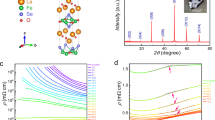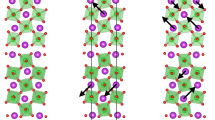Abstract
Metals cannot exhibit ferroelectricity because static internal electric fields are screened by conduction electrons1, but in 1965, Anderson and Blount predicted the possibility of a ferroelectric metal, in which a ferroelectric-like structural transition occurs in the metallic state2. Up to now, no clear example of such a material has been identified. Here we report on a centrosymmetric ( ) to non-centrosymmetric (R3c) transition in metallic LiOsO3 that is structurally equivalent to the ferroelectric transition of LiNbO3 (ref. 3). The transition involves a continuous shift in the mean position of Li+ ions on cooling below 140 K. Its discovery realizes the scenario described in ref. 2, and establishes a new class of materials whose properties may differ from those of normal metals.
) to non-centrosymmetric (R3c) transition in metallic LiOsO3 that is structurally equivalent to the ferroelectric transition of LiNbO3 (ref. 3). The transition involves a continuous shift in the mean position of Li+ ions on cooling below 140 K. Its discovery realizes the scenario described in ref. 2, and establishes a new class of materials whose properties may differ from those of normal metals.
This is a preview of subscription content, access via your institution
Access options
Subscribe to this journal
Receive 12 print issues and online access
$259.00 per year
only $21.58 per issue
Buy this article
- Purchase on Springer Link
- Instant access to full article PDF
Prices may be subject to local taxes which are calculated during checkout



Similar content being viewed by others
References
Lines, M. E. & Glass, A. M. Principles and Applications of Ferroelectrics and Related Materials (Oxford Univ. Press, 2001).
Anderson, P. W. & Blount, E. I. Symmetry considerations on martensitic transformations: ‘Ferroelectric’ metals? Phys. Rev. Lett. 14, 217–219 (1965).
Boysen, H. & Altorfer, F. A neutron powder investigation of the high-temperature structure and phase transition in LiNbO3 . Acta Crystallogr. B 50, 405–414 (1994).
Testardi, L. R. Structural instability and superconductivity in A-15 compounds. Rev. Mod. Phys. 47, 637–648 (1975).
Paduani, C. & Kuhnen, C. A. Martensitic phase transition from cubic to tetragonal V3Si: An electronic structure study. Eur. Phys. J. 66, 353–359 (2008).
Sergienko, I. A. et al. Metallic ferroelectricity in the pyrochlore Cd2Re2O7 . Phys. Rev. Lett. 92, 065501 (2004).
Tachibana, M., Taira, N., Kawaji, H. & Takayama-Muromachi, E. Thermal properties of Cd2Re2O7 and Cd2Nb2O7 at the structural phase transitions. Phys. Rev. B 82, 054108 (2010).
Kolodiazhnyi, T., Tachibana, M., Kawaji, H., Hwang, J. & Takayama-Muromachi, E. Persistence of ferroelectricity in BaTiO3 through the insulator-metal transition. Phys. Rev. Lett. 104, 147602 (2010).
Jeong, I-K. et al. Structural evolution across the insulator-metal transition in oxygen-deficient BaTiO3−δ studied using neutron total scattering and Rietveld analysis. Phys. Rev. B 84, 064125 (2011).
Navrotsky, A. Energetics and crystal chemical systematics among ilmenite, lithium niobate, and perovskite structures. Chem. Mater. 10, 2787–2793 (1998).
Abrahams, S. C., Buehler, E., Hamilton, W. C. & Laplaca, S. J. Ferroelectric lithium tantalate—III. Temperature dependence of the structure in the ferroelectric phase and the para-electric structure at 940 °K. J. Phys. Chem. Solids 34, 521–532 (1973).
Toledano, J. C. & Toledano, P. The Landau Theory of Phase Transitions (World Scientific, 1987).
Campbell, B. J., Stokes, H. T., Tanner, D. E. & Hatch, D. M. ISODISPLACE: A web-based tool for exploring structural distortions. J. Appl. Crystallogr. 39, 607–614 (2006).
Tanaka, M. & Tsuda, K. Convergent-beam electron diffraction. J. Electron Microsc. 60, S245–S267 (2011).
Ohgushi, K. et al. Structural and electronic properties of pyrochlore-type A2Re2O7 (A = Ca, Cd, and Pb). Phys. Rev. B 83, 125103 (2011).
Shi, Y. G. et al. Continuous metal–insulator transition of the antiferromagnetic perovskite NaOsO3 . Phys. Rev. B 80, 161104(R) (2009).
Jin, R. et al. Fluctuation effects on the physical properties of Cd2Re2O7 near 200 K. J. Phys. Condens. Matter 14, L117–L123 (2002).
Hiroi, Z., Hanawa, M., Muraoka, Y. & Harima, H. Correlations and semimetallic behaviors in pyrochlore oxide Cd2Re2O7 . J. Phys. Soc. Jpn 72, 21–24 (2003).
Storchak, V. G. et al. Spin polarons in the correlated metallic pyrochlore Cd2Re2O7 . Phys. Rev. Lett. 105, 076402 (2010).
Abrahams, S. C., Levinstein, H. J. & Reddy, J. M. Ferroelectric lithium niobate. 5. Polycrystal X-ray diffraction study between 24 and 1200 °C. J. Phys. Chem. Solids 27, 1019–1026 (1966).
Weis, R. S. & Gaylord, T. K. Lithium niobate: Summary of physical properties and crystal structure. Appl. Phys. A 37, 191–203 (1985).
Prokhorov, A. M. & Kuz’minov, Y. S. Physics and Chemistry of Crystalline Lithium Niobate (Adam Hilger, 1990).
Ohkubo, Y. et al. Mechanism of the ferroelectric phase transition in LiNbO3 and LiTaO3 . Phys. Rev. B 65, 052107 (2002).
Yildirim, T. Ferroelectric soft phonons, charge density wave instability, and strong electron-phonon coupling in BiS2 layered superconductors: A first-principles study. Phys. Rev. B 87, 020506(R) (2013).
Acknowledgements
We thank M. Miyakawa (NIMS) for the high-pressure synthesis experiment, H. X. Yang (CAS) and J. Q. Li (CAS) for the ED study, S. Takenouchi (NIMS) for the AAS, and A. Aimi (Gakushuin Univ.), M. Tachibana (NIMS) and M. Terauchi (Tohoku Univ.) for discussion and suggestions. This research was supported in part by the World Premier International Research Center from MEXT, Japan; a Grant-in-Aid for Scientific Research (22246083 and 25289233) from JSPS, Japan; the Funding Program for World-Leading Innovative R&D on Science and Technology (FIRST Program) from JSPS, Japan; the Advanced Low Carbon Technology Research and Development Program (ALCA) of the Japan Science and Technology Agency (JST), Japan; the 973 project of the Ministry of Science and Technology of China (No. 2011CB921701 and 2011CBA00110), China; and the United Kingdom Engineering and Physical Sciences Research Council (EPSRC).
Author information
Authors and Affiliations
Contributions
Y.S. and K.Y. conceived the experiments. Y.S. grew and characterized the crystals together with Y.G., X.W., S.Y. and N.W. Y.M. and A.S. conducted crystal structure analysis by XRD. A.J.P., Y.G., D.K. and P.M. performed powder neutron diffraction measurements and analysis. K.T. performed the CBED experiments, data analysis, and data interpretation. M. Arai investigated the electronic structure by first-principles calculation. Y.S. and M. Akaogi investigated the crystal structure stability under high-pressure conditions. K.Y. and A.T.B. supervised the project and co-wrote the paper. All authors discussed the results and reviewed the manuscript.
Corresponding authors
Ethics declarations
Competing interests
The authors declare no competing financial interests.
Supplementary information
Supplementary Information
Supplementary Information (PDF 541 kb)
Rights and permissions
About this article
Cite this article
Shi, Y., Guo, Y., Wang, X. et al. A ferroelectric-like structural transition in a metal. Nature Mater 12, 1024–1027 (2013). https://doi.org/10.1038/nmat3754
Received:
Accepted:
Published:
Issue Date:
DOI: https://doi.org/10.1038/nmat3754
This article is cited by
-
Nonzero spontaneous electric polarization in metals: novel predictive methods and applications
Scientific Reports (2024)
-
Clues to potential dipolar-Kondo and RKKY interactions in a polar metal
npj Quantum Materials (2023)
-
Quantum fluctuation of ferroelectric order in polar metals
npj Quantum Materials (2023)
-
Kibble–Zurek mechanism of Ising domains
Nature Physics (2023)
-
Superconductivity in a ferroelectric-like topological semimetal SrAuBi
npj Quantum Materials (2023)



